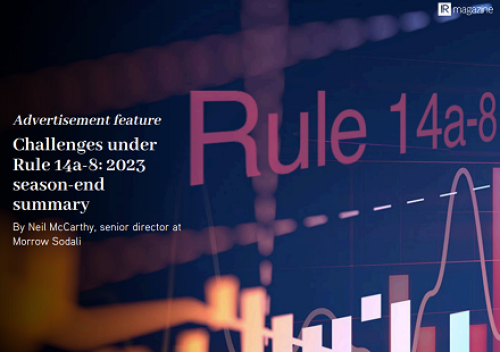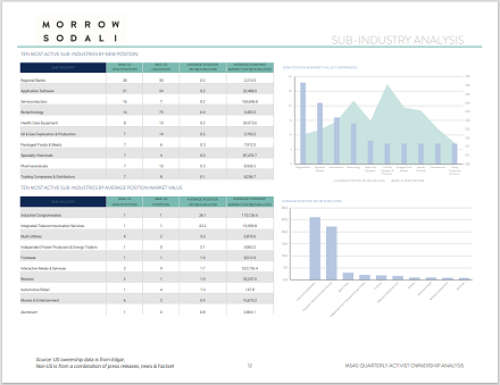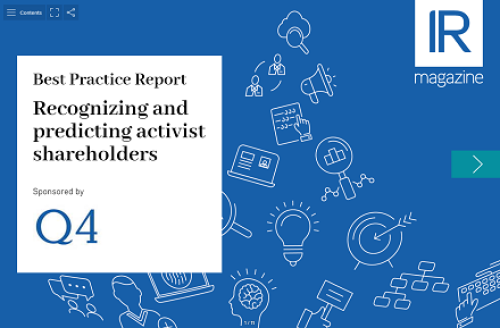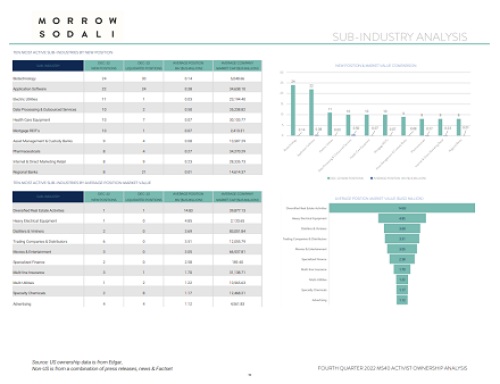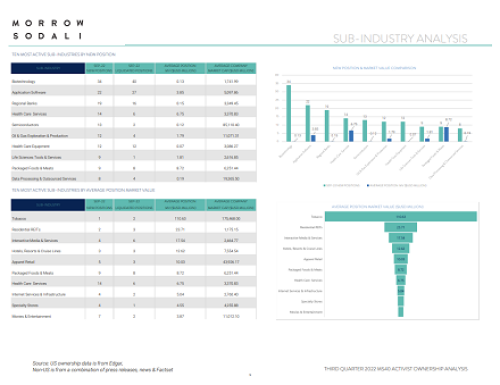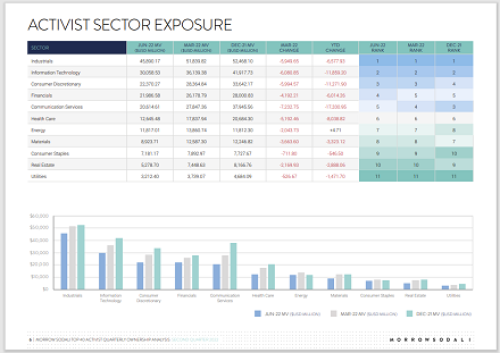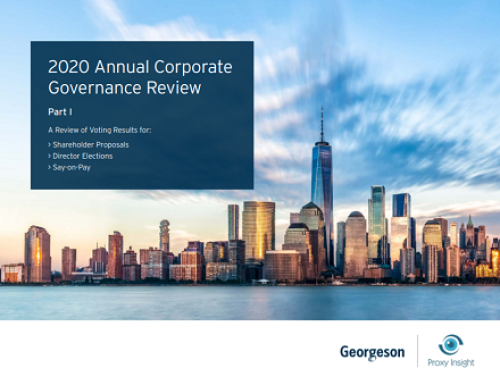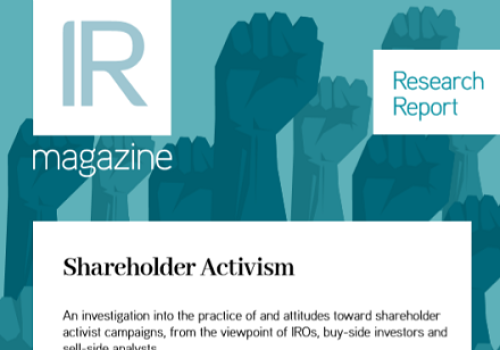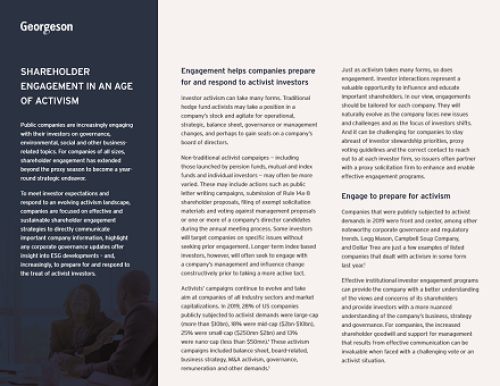Analyzing activist investors’ true motivations
Activist investors are extremely selective stock pickers looking to enhance returns by resolving a perceived vulnerability. Not only is their execution typically confined to a set of select strategies, but our research also indicates their screening process can be defined by a handful of fundamental metrics. But this is not a new paradigm we’re observing; this trend has remained a consistent mainstay among conventional activist engagement over the last three years.
While we can attribute vulnerability profiles to a small set of fundamentals, free cash and its corresponding metrics are perhaps the best gauge of activist susceptibility. Accordingly, it is imperative that management understands the double-edged sword of free cash: while it is an attractive luxury to boast to the marketplace, it also transmits an extremely enticing signal to an activist investor.
Preliminary stimuli of true activists
In order to identify patterns among conventional activists, it is critical to first separate investors that resort to activism from investors whose strategy originates with activism. This is a subtle, but crucial, distinction management should be cognizant of when examining the standard activist mind-set.
Moving forward with a 13D filing does not suggest an investor should be automatically considered an ‘activist’. Often, investors undeservingly become grouped into that unique category after they have exhausted other means of addressing their concerns as traditional long term-oriented shareholders. In short, using activism as an alternative last resort is far different from employing activism as a preliminary strategy.
Conventional activist investors are usually long term-focused as well, but aggressively enter a stock by applying the customary activist mind-set: aligning future performance with perceived potential. These are the specific investors we identify as tier 1 activists, not because they purely file a 13D, but because of what their screening process entails and how they execute their respective strategy. Consequently, these are also the investors that are constantly seeking access to free cash.
Free cash’s supplemental vulnerability metric
Companies targeted by tier 1 activists also typically trade at a discounted multiple for an extended period of time. Over the last three years, the majority of tier 1 targets have displayed trading multiples that generally lagged the S&P 500 median. Based on the most recent 13F filings, this trend remains in place, as the most recent buys and holds of the tier 1 activists exhibit median trading multiples that range between the 30th and 40th percentile versus the S&P 500.
This dynamic implies there is an underlying discrepancy that compels investors not to pay at least a market multiple for the stock. In order to bridge this valuation gap, management’s predicament lies in figuring out what that specific discrepancy may be.
In some cases, such as energy, the lag in multiple could be a function of struggling macro variables. When that is not the case, however, company vulnerability can be contingent upon a variety of fundamental characteristics. In some instances, profitability ratios may be most visible; in others, efficiency ratios appear to be the primary culprit. Based on our research, however, there is a common underlying disparity among the undervalued activist targets: the combination of a lagging trading multiple and perceived mismanagement of free cash. Combined, these metrics enhance the odds of a tier 1 activist engagement.
Poor doesn’t really mean poor
There is also a common misconception that tier 1 activists attack poor performers. Unfortunately, the term ‘poor’ is subjective and often incorrectly associated with ‘inefficient’. While a number of poorly performing companies have fallen into the crosshairs of a tier 1 activist, our studies reveal that more recent activist targets display efficiency and profitability ratios that are not far off their respective market medians. Our findings reveal that tier 1 activists actually prefer targets that maintain efficiency and profitability ratios between the 40th and 60th percentile relative to the S&P 500.
Focusing on this specific area of performance tends to provide management teams with a false sense of security, especially when it coincides with a lagging price multiple. Instead of addressing why respectable ratios do not result in a stock price that reflects a market multiple, management teams tend to argue and rationalize that the market simply does not understand them. This is a common pitfall that activists prey upon.
The disparity between adequate efficiency or profitability ratios and a corresponding gap in trading multiple exposes a significant component of the activist’s motivation. The term ‘inefficient’ is less indicative of traditional efficiency/profitability ratios and more symptomatic of an activist’s evaluation of management’s approach to capital deployment, especially free cash.
Our studies uncover that no other metric acts as a better proxy of potential (that is, affordability and sustainability) than free cash. Examining free cash yield, free cash-to-revenue and free cash-to-operational cash flow not only reveals the companies that have access to free cash, but is also suggestive of capital deployment efficiency. In fact, our findings show that 86 percent of the tier 1 targeted companies that display either lagging multiples or lagging payout ratios also display ‘excess’ free cash ratios, or ratios that measure above their respective market medians.
More importantly, our data indicates that free cash is agnostic to specific campaigns. In other words, it does not matter whether the activist is focusing on buybacks or dividend yield, spinning off a non-performing asset or wanting to achieve synergies from merging two similar competitors. The objective is to unlock shareholder wealth, and free cash appears to be the most efficient instrument in allowing that to come to fruition.
Free cash is key barometer of opportunity cost
Of course there are other complementary metrics investors take into account during their examination. In terms of identifying the proverbial North Star of fundamentals, however, the principal proxy for activist vulnerability lies in scrutinizing management’s historical generation and allocation of free cash. Activists do not want to enter a stock whose operations need a complete overhaul. Instead, they seek one or two persuasive levers that, when pulled, result in enhanced shareholder wealth. In this respect, the allocation of free cash not only offers the most cost-effective path, but also provides the path of least resistance.
Management should be constantly addressing and evaluating its track record regarding capital allocation, particularly free cash. While it is an impressive metric to showcase within the market, it also grabs the attention of all types of investors. As more than the optimal ratio of free cash is diverted to riskier campaigns that traditionally earn lower internal rates of return (IRRs) – such as M&A – the corresponding opportunity cost of the investment drastically increases. Once again, it is critical to be mindful of terminology: lower IRR does not imply ‘poor’ – rather, it implies higher opportunity costs, which activists constantly seek to remedy.
Lastly, management should continually benchmark its free cash position against a set of competitive peers along with the firm’s respective industry. In most cases, a performance metric that exceeds a given benchmark ordinarily provides a facet of the business that should be emphasized to the market. This is not necessarily the case with free cash.
We feel tier 1 activists view the ‘hoarding’ of excess free cash over the course of time more as an opportunistic inefficiency than an accomplishment. Excess free cash more often than not increases the opportunity cost of an investment and also provides one of the coveted levers that has the capability of unleashing additional shareholder wealth. Especially when combined with a lagging multiple, management teams need to be aware that boasting access to free cash can actually increase vulnerability instead of emphasizing current performance.
Daniel Romito is a senior analyst in global targeting at Nasdaq Advisory Services

